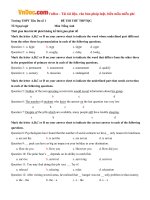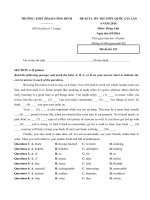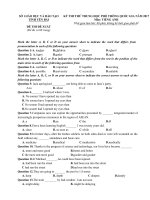Đề thi thử lần 7 đợt 2 THPTQG môn Tiếng Anh Cô Ngọc
Bạn đang xem bản rút gọn của tài liệu. Xem và tải ngay bản đầy đủ của tài liệu tại đây (665.92 KB, 12 trang )
<span class="text_page_counter">Trang 1</span><div class="page_container" data-page="1">
<b>ĐỀ THI THỬ LẦN 7 ĐỢT 2 TỦ SÂU MÔN ANH THPTQG </b>
<i><b>Mark the letter A, B, C or D on your answer sheet to indicate the word whose underlined part differs from the other three in pronunciation in each of the following questions. </b></i>
<b>Question 1: A. booked B. established C. preferred D. stopped Question 2: A. age B. cat C. fat D. bag </b>
<i><b>Mark the letter A, B, C or D on your answer sheet to indicate the word that differs from the other three in the position of primary stress in each of the following questions. </b></i>
<b>Question 3: A. believe B. marriage C. response D. maintain Question 4: A. summary B. different C. physical D. decision </b>
<i><b>Mark the letter A, B, C or D on your answer sheet to indicate the correct answer to each of the following questions. </b></i>
<b>Question 5: While studying, he was financially dependent _______ his parents. A. to B. from C. on D. of Question 6: Surely David’s not going to drive, __________? </b>
<b>A. does he B. is he C. isn’t he D. will he Question 7: The injured __________ to the hospital in an ambulance. </b>
<b>A. were taking B. was taking C. were taken D. have taken Question 8: Jack has a collection of __________. </b>
<b>A. old valuable Japanese postage stamps B. old Japanese valuable postage stamps C. valuable Japanese old postage stamps D. valuable old Japanese postage stamps </b>
</div><span class="text_page_counter">Trang 2</span><div class="page_container" data-page="2"><b>Question 9: I thought the party ________ really well. </b>
<b>A. came off B. came up C. came about D. came across Question 10: Mary will have finished all her work _______. </b>
<b>A. by the time her boss returns B. until her boss will return C. as soon as her boss returned D. when her boss had returned </b>
<b>Question 11: John will never buy you a drink let alone a present – he’s far too ______. A. big – headed B. easy – going C. highly – strung D. tight – fisted </b>
<b>Question 12: Does television adequately reflect the ethnic and cultural _______ of the country? A. diversify B. diversely C. diverse D. diversity </b>
<b>Question 13: Over the last century, there _____ many significant changes in the way we live. A. were B. had been C. are D. have been </b>
<b>Question 14: Students were allowed to stay at home instead of going to school for a month due to a </b>
<b>serious ______ of Covid – 19 pandemic. </b>
<b>A. outcome B. outset C. outbreak D. outburst </b>
<b>Question 15: It was hard to ______ the temptation to watch the late – night show even though I was so </b>
tired then.
<b>A. object B. admit C. refuse D. resist </b>
<b>Question 16: I agreed that the shop treated you very badly. But just write a polite letter of complaint. </b>
It’s not worth making a ______ about it.
<b>A. song and dance B. length and breadth C. pins and needles D. tooth and nail </b>
</div><span class="text_page_counter">Trang 3</span><div class="page_container" data-page="3"><b>Question 17: The more ____________ and positive you look, the better you will feel when you come to a </b>
job interview.
<b>A. confide B. confident C. confidence D. confidently Question 18: ___________ the book, I wrote down some notes. </b>
<b>A. Being read B. To read C. Read D. Having read Question 19: The sky was cloudy and foggy. We went to the beach, ______. </b>
<b>A. yet B. even though C. however D. so </b>
<i><b>Mark the letter A, B, C or D on your answer sheet to indicate the word(s) CLOSEST in meaning to the underlined word(s) in each of the following questions. </b></i>
<b>Question 20: This was why Quentin has chosen to became an investigative journalist. A. nosy B. inquiring C. curious D. meddling </b>
<b>Question 21: Quentin had unearthed new evidence that the landlord of Regina had a part to play </b>
regarding the children that had recently disappeared.
<b>A. unveiled B. exposes C. disclosed D. uncovered </b>
<i><b>Mark the letter A, B, C or D on your answer sheet to indicate the word(s) OPPOSITE in meaning to the underlined word(s) in each of the following questions. </b></i>
<b>Question 22: Mr and Mrs. Brandon did not show up at the party last night. </b>
<b>A. leave B. attend C. haunt D. frequent </b>
<b>Question 23: They are going to celebrate their wedding anniversary by holding a dinner party at the </b>
Italian restaurant.
<b>A. disregard B. remember C. honour D. commiserate </b>
</div><span class="text_page_counter">Trang 4</span><div class="page_container" data-page="4"><i><b>Mark the letter A, B, C, or D on your answer sheet to indicate the most suitable response to complete each of the following exchanges. </b></i>
<i><b>Question 24: Jenny and Jimmy are talking about university education. </b></i>
<b>Jenny: “I think having a university degree is the only way to succeed in life.” Jimmy: “___________. There were successful people without a degree.” </b>
<b>A. That’s all right. B. I don’t quite agree. C. I can’t agree more. D. That’s life. </b>
<i><b>Question 25: Adam and Janet are at the school canteen. </b></i>
<b>Adam: “______________” Janet: “Yes, please.” </b>
<b>A. It’s a bit hot in here, isn’t it? B. Do you mind if I sit here? C. Can you pass me the salt, please? D. Would you like a cup of coffee? </b>
<i><b>Mark the letter A, B, C or D on your answer sheet to indicate the correct word(s) or phrase(s) that best fit(s) each of the numbered blanks from 26 to 30. </b></i>
Have you heard about the great flood? Perhaps you have heard about a man named Noah, who built a
<b>huge boat to escape the flood. In this legend of the great flood, water covered all the land, killing most of the people and animals on Earth. Only Noah's (26) _______ family, including his wife, three sons, and </b>
the sons' wives, survived the flood, along with all of the animals on his boat. After the flood waters receded, the people and animals on Noah’s boat set about repopulating the Earth. This legend of Noah
<b>and his family is familiar to many people. However, it is not the only legend about a great flood. Actually, many cultures have similar stories about a great flood that wiped (27) _______ almost everyone on Earth. Many people today believe that the great flood is only a legend. (28) _______ other people say that the </b>
striking similarities among all of the flood legends suggest that a real flood covered the Earth at some
</div><span class="text_page_counter">Trang 5</span><div class="page_container" data-page="5"><b>point long ago. In fact, some scientists (29) _______ that the ancient flood waters are now frozen in </b>
glaciers at the poles of the Earth. But why do the legends disagree with each other? The flood happened
<b>long before humans could write, so the story of the flood could only be (30) _______ through generations </b>
by oral retellings. As the story was passed by word of mouth, it may have changed as various cultures learned the story. This may explain why some parts of the legend differ. Through careful examination of similar elements in these legends, however, certain facts about an accident catastrophic flood may be revealed.
<i>(Adapted from Reading Challenge 3 by Casey Malarcher and Andrea Janzen) </i>
<b>Question 26: A. immediate B. extended C. nuclear D. present Question 27: A. down B. off C. out D. away Question 28: A. In addition B. Nonetheless C. On the contrary D. In contrast Question 29: A. speculated B. have speculated C. are speculating D. speculate </b>
<b>Question 30: A. altered B. converted C. perpetuated D. bequeathed </b>
<i><b>Read the following passage and mark the letter A, B, C or D on your answer sheet to indicate the correct answer to each of the following questions from 31 to 35. </b></i>
The first Industrial Revolution was about harnessing steam power so that muscle could be replaced by machines. The second was driven by electricity and a cluster of inventions from the late 19th century onwards - including the internal combustion engine, the aeroplane and moving pictures. A third revolution began in the 1960s and was based on digital technology, personal computing and the development of the Internet. Industrial Revolution 4.0 will be shaped by a fresh wave of innovation in areas such as driverless cars, smart robotics, materials that are lighter and tougher, and a manufacturing process built around 3D printing.
There are some myths about Industrial Revolution 4.0. The first is that it won’t really have as big an impact as the previous periods of change, most especially the breakthroughs associated
</div><span class="text_page_counter">Trang 6</span><div class="page_container" data-page="6">with the second industrial revolution. In the past, it has always taken time to feel the full effects of technological change and many of today's advances are in their infancy. It is far too early to say that the car or air travel will prove to be less important than the sequencing of the human genome or synthetic biology. The second myth is that the process will be trouble free provided everything is left to the market. It is a fantasy to believe that the wealth created by the fourth Industrial Revolution will cascade down from rich to poor, and that those displaced will just walk into another job that pays just as well.
Indeed, all the evidence so far is that the benefits of the coming change will be
<b>concentrated among a relatively small elite, thus exacerbating the current trend towards greater levels </b>
of inequality. This was a point stressed by the Swiss bank UBS in a report launched in Davos. It notes that there will be a “polarization of the labor force as low-skill jobs continue to be automated and this trend increasingly spreads to middle class jobs."
<i>(Adapted from </i>
<b>Question 31: The best title for this passage could be___________ A. Four Industrial Revolutions in human history </b>
<b>B. Some myths about four Industrial Revolutions C. The benefits of the fourth Industrial Revolution D. The greatest inventions in human history </b>
<b>Question 32: Which statement about four Industrial Revolutions is NOT TRUE according to the </b>
passage?
<b>A. The first Industrial Revolution brought about steam power machines. </b>
<b>B. A third revolution began in the 1970 and led to the development of the Internet. </b>
<b>C. The second was driven by electricity and a cluster of inventions from the late 19</b><small>th </small>century onwards.
</div><span class="text_page_counter">Trang 7</span><div class="page_container" data-page="7"><b>D. Driverless cars, smart robotics can be said to be products of Industrial Revolution 4.0 Question 33: The word “it" in paragraph 2 refers to___________? </b>
<b>A. myths B. Industrial Revolution 1.0 C. Industrial Revolution 3.0 D. Industrial Revolution 4.0 Question 34: In paragraph 2, the writer suggests that___________ </b>
<b> A. Industrial Revolution 4.0 will really have as big an impact as the previous periods of change. </b>
<b>B. Many of today's advances resemble those in the past. </b>
<b>C. It is far too early to say that the sequencing of the human genome or synthetic biology will prove to </b>
be more significant than the car or air travel.
<b>D. The fourth Industrial Revolution will cascade down from rich to poor. Question 35: The word “exacerbating” in paragraph 3 means___________ </b>
<b>A. worsening B. lessening C. minimizing D. changing </b>
<i><b>Read the following passage and mark the letter A, B, C or D on your answer sheet to indicate the correct answer to each of the following questions from 36 to 42. </b></i>
<b> There are three basic types of classroom learning styles: visual, auditory, and kinesthetic. These </b>
learning styles describe the most common ways that people learn. Individuals tend to instinctively
<b>prefer one style over the others; thus each person has a learning style that is dominant even though he </b>
or she may also rely somewhat on the other approaches at different times and in different circumstances.
Visual learners prefer to sit somewhere in the classroom where no obstructions hinder their view of the lesson. They rely on the teacher's facial expressions and body language to aid their learning. They learn best from a blend of visual displays and presentations such as colorful videos, diagrams, and flip-charts. Often, these learners think in pictures and may even close their eyes to visualize or remember
</div><span class="text_page_counter">Trang 8</span><div class="page_container" data-page="8">something. When they are bored, they look around for something to watch. Many visual learners lack confidence in their auditory memory skills and so may take detailed notes during classroom discussions and lectures.
Auditory learners sit where they can hear well. They enjoy listening and talking, so discussions and verbal lectures stimulate them. Listening to what others have to say and then talking the subject
<b>through helps them process new information. These learners may be heard reading to themselves out </b>
loud because they can absorb written information better in this way. Sounding out spelling words, reciting mathematical theories, or talking their way across a map are examples of the types of activities that improve their understanding.
Kinpsthptic learners may find it difficult to sit still in a conventional classroom. They need to be physically active and take frequent breaks. When they are bored, they fidget in their seats. They prefer to sit someplace where there is room to move about. They benefit from manipulating materials and learn best when classroom subjects such as math, science, and reading are processed through hands-on experiences. Incorporating arts-and-crafts activities, building projects, and sports into lesshands-ons helps kinesthetic learners process new information. Physical expressions of encouragement, such as a pat on the back, are often appreciated.
In addition to these traditional ways of describing learning styles, educators have identified other ways some students prefer to learn. Verbal learners, for example, enjoy using words, both written and spoken. Logical learners are strong in the areas of logic and reasoning. Social learners do best when working in groups, whereas solitary learners prefer to work alone. Research shows that each of these learning styles, as well as the visual, auditory, and kinesthetic styles, uses different parts of the brain. Students may prefer to focus on just one style, but practicing other styles involves more of the brain's potential and therefore helps students remember more of what they learn.
<i>(Adapted from Essential words for the IELTS by Dr. Lin Lougheed) </i>
</div><span class="text_page_counter">Trang 9</span><div class="page_container" data-page="9"><b>Question 36: What topic does the passage mainly discuss? A. Fundamental kinds of learning approaches </b>
<b>B. Different classrooms for different learner groups C. The most common way to learn </b>
<b>D. Basic classrooms for individuals </b>
<b>Question 37: The word “dominant” in the first paragraph is closest in meaning to A. successful B. foremost C. familiar D. distinctive Question 38: According to the second paragraph, visual learners _______ </b>
<b>A. have a preference for sitting at the backs of the classrooms </b>
<b>B. must keep an eye on the pictures to memorize the content of the lessons C. are easy to get fed up with the lessons. </b>
<b>D. are not confident in remembering what they have listened. </b>
<b>Question 39: The word "them" in the third paragraph refers to _______ </b>
<b>A. auditory learners B. discussions C. verbal lectures D. others Question 40: Which of the following is NOT true about auditory learners? </b>
<b>A. They get information and the content of the lecturers aurally and orally. B. Reciting the lessons aloud is an effective way to understand the subjects, C. They always fidget when they are indifferent to the lectures. </b>
<b>D. They merely learn well when they are able to listen to the lessons clearly. </b>
</div><span class="text_page_counter">Trang 10</span><div class="page_container" data-page="10"><b>Question 41: The following are suggested methods to attract kinesthetic learners, EXCEPT A. merging arts-and-crafts activities </b>
<b>B. integrating projects and sports into the lessons C. stimulating them by physical expressions D. isolating them in a customary classroom </b>
<b>Question 42: What did the author suggest learners in order to keep in their mind what they learnt in </b>
the last paragraph?
<b>A. practicing merely one style of learning to make the brain work more effectively. B. Using variety of learning methods to increase the potential of their brain. </b>
<b>C. Using both written and spoken words to improve their logical thoughts. D. Identifying the most suitable learning style themselves. </b>
<i><b>Mark the letter A, B, C or D on your answer sheet to indicate the underlined part that needs correction in each of the following questions. </b></i>
<b>Question 43. The University of Kentucky has held this prestigious title until 1989, when it was granted to the University of Georgia. </b>
<b>A. has held B. it C. was granted D. of </b>
<b>Question 44. Charities such as Oxfam are always trying to recruit volunteers to help in its work. A. such as B. are always C. to recruit D. in its work </b>
<b>Question 45. My mother couldn't bare waste - she always made us eat everything on our plates. A. couldn't bare B. made C. eat everything D. our plates </b>
</div>








